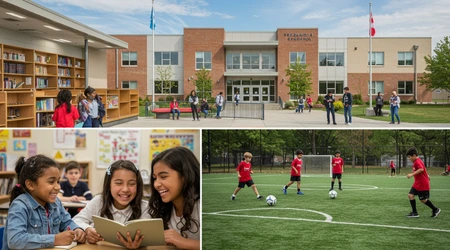Curriculum for Inclusion: Saskatchewan’s Parents’ Bill of Rights and What It Means for Students

The curriculum for inclusion lies at the heart of modern education, striving to create equitable learning environments where every student feels seen and valued.
In Saskatchewan, this pursuit has collided with the controversial Parents’ Bill of Rights, or Bill 137, enacted in 2023.
This legislation, requiring parental consent for students under 16 to use gender-related names or pronouns at school, has sparked heated debates about balancing inclusion with parental authority.
As schools navigate this law in 2025, its ripple effects touch students, educators, and communities, raising critical questions about identity, safety, and the role of education in fostering diversity.
How can schools uphold a curriculum for inclusion while respecting diverse family values? This article dives deep into the implications of Bill 137, exploring its impact on students and the broader educational landscape.
The tension between inclusion and parental rights isn’t new, but Saskatchewan’s law has intensified the conversation.
Passed amid protests and legal challenges, Bill 137 reflects a broader global trend of policies emphasizing parental control over education.
Yet, inclusion advocates argue it risks marginalizing gender-diverse students, potentially undermining their mental health and sense of belonging.
This piece examines the law’s origins, its classroom consequences, and the delicate balance schools must strike to ensure every student thrives.
Through real-world examples, data, and thoughtful analysis, we’ll unpack what this means for Saskatchewan’s education system and beyond.
The Origins of the Parents’ Bill of Rights
Saskatchewan’s Parents’ Bill of Rights emerged from a 2023 policy shift prioritizing parental involvement in sensitive school matters.
The law mandates that schools obtain consent before allowing students under 16 to use preferred names or pronouns differing from their birth certificates.
Framed as a safeguard for family values, it responded to concerns from some parents about rapid social changes in schools.
Supporters argue it empowers families to guide their children’s identity development, aligning education with personal beliefs.
Yet, the law’s passage wasn’t smooth. Critics, including the Saskatchewan Human Rights Commission, condemned its use of the notwithstanding clause, which overrides certain Charter rights.
Heather Kuttai, a former commissioner, resigned in protest, calling it an assault on gender-diverse youth. The curriculum for inclusion, designed to foster safe spaces, now faces scrutiny as schools navigate parental consent requirements.
++ Provincial Student Aid Boost: Newfoundland & Labrador Raises Grants by 20%
This tension highlights a broader question: whose rights take precedence in shaping a child’s education?
The law’s roots trace back to public consultations and rising cultural debates. In 2022, Saskatchewan’s government surveyed parents, finding 58% supported stronger parental oversight in schools, according to a provincial report.
This statistic fueled Bill 137’s momentum, but critics argue it sidelined marginalized voices. The debate continues to polarize, with some seeing it as a necessary check on schools, while others view it as a step backward for inclusion.

Classroom Impacts: Navigating Inclusion and Compliance
In classrooms, the Parents’ Bill of Rights has reshaped how teachers approach gender identity. Educators must now verify parental consent before acknowledging a student’s preferred name or pronoun, a process that can feel intrusive.
For example, consider Mia, a 14-year-old transgender student in Regina. Mia wants to be called by her chosen name at school, but her parents, unaware of her identity, haven’t consented.
Teachers, bound by law, must use her birth name, potentially outing her or causing distress.
This scenario underscores a challenge for the curriculum for inclusion. Teachers strive to create supportive environments, but legal constraints can create friction.
Gender and Sexuality Alliances (GSAs), student-led clubs promoting inclusivity, report heightened anxiety among members.
Also read: Canada Expands Student Loan Forgiveness to 10 Rural Health & Social Service Professions
One GSA leader in Saskatoon shared, “Kids are scared their identities won’t be respected.” The law’s enforcement has led some schools to limit discussions on gender, fearing legal repercussions, which dilutes inclusive education efforts.
The administrative burden is another hurdle. Schools must track consent forms, adding paperwork and potential errors. Some educators worry this shifts focus from teaching to compliance.
Meanwhile, students like Mia navigate a system where their identity hinges on parental approval, raising questions about autonomy and safety.
Can a curriculum for inclusion thrive under such constraints, or does it risk alienating those it aims to uplift?
Student Well-Being: The Heart of the Debate
The emotional toll on students is a critical concern. Gender-diverse youth often rely on schools as safe havens, especially if home environments are unsupportive.
Bill 137’s consent requirement can force students to disclose their identities to parents prematurely, risking rejection or harm.
A 2023 study by Egale Canada found 64% of transgender youth in unsafe home environments reported increased anxiety due to similar policies. This data underscores the stakes for student mental health.
Imagine a student like Alex, a 15-year-old in Moose Jaw, who identifies as non-binary but fears parental backlash. Without school support, Alex feels isolated, unable to express their identity. The curriculum for inclusion aims to affirm such students, but Bill 137 complicates this.
Teachers, caught between policy and empathy, may hesitate to engage, leaving students like Alex in limbo. GSAs offer some refuge, but their reach is limited without broader systemic support.
Advocates argue the law prioritizes parental rights over student well-being. Critics counter that families, not schools, should guide identity discussions.
Read more: AI in Classrooms: Innovative Pilot Programs Reshaping Learning in 2025
Both sides agree on one thing: students’ mental health is paramount. Yet, the law’s structure often leaves educators navigating a minefield, balancing legal obligations with their duty to protect students. This tension challenges the core of inclusive education.
The Broader Educational Landscape
Beyond Saskatchewan, Bill 137 reflects a global push for parental control in education. In the U.S., a 2025 Supreme Court ruling (Mahmoud v. Taylor) allowed parents to opt out of LGBTQ+-inclusive lessons, citing religious freedom.
This parallels Saskatchewan’s approach, raising questions about how far parental rights extend. Schools worldwide grapple with similar debates, from Alberta’s vetting of sex education to California’s curriculum revisions.
Locally, the law has prompted Saskatchewan school boards to revise policies. In 2025, divisions began sharing change room policies publicly, aligning with transparency mandates.
This shift aims to build trust but adds complexity to inclusive practices. The curriculum for inclusion must now weave through legal frameworks, potentially diluting its impact.
Some districts preemptively limit gender-related content to avoid conflicts, a trend seen in U.S. schools post-Mahmoud.
This cautious approach risks eroding the curriculum for inclusion. If schools shy away from diverse topics, students miss opportunities to learn about varied identities, hindering social cohesion.
Conversely, transparency can foster dialogue, encouraging parents and educators to collaborate. The challenge lies in ensuring these policies don’t silence marginalized voices while addressing parental concerns.
Striking a Balance: Practical Solutions
Finding equilibrium between inclusion and parental rights requires creativity. Schools could adopt tiered consent models, allowing partial opt-outs while preserving core inclusive content. For instance, parents might opt out of specific lessons but not broader diversity education.
This mirrors Ohio’s Parents’ Bill of Rights, which balances opt-outs with curriculum access. Such models maintain the curriculum for inclusion while respecting family values.
Professional development is another key. Training teachers to navigate sensitive topics with neutrality can bridge gaps.
In Saskatoon, one school piloted workshops where educators practiced facilitating identity discussions without violating Bill 137.
Results showed improved teacher confidence and student trust. Expanding such programs could empower schools to uphold inclusion despite legal constraints.
Community engagement is vital. Schools could host forums where parents, students, and educators discuss the curriculum for inclusion.
These dialogues, like one held in Prince Albert in 2025, foster understanding and reduce polarization. By involving all stakeholders, schools can craft policies that honor both inclusion and parental input, ensuring students feel supported.
A Path Forward: Reimagining Inclusion

The Parents’ Bill of Rights challenges Saskatchewan’s education system to rethink inclusion. Rather than a one-size-fits-all approach, schools could personalize support for gender-diverse students.
For example, counselors could offer private identity support without requiring parental consent, provided it aligns with legal boundaries. This ensures students like Mia or Alex have safe spaces, even under restrictive policies.
Technology offers solutions too. Digital platforms could provide optional, parent-approved modules on gender diversity, allowing flexibility within the curriculum for inclusion.
Such tools empower students to explore identities at their own pace while respecting parental oversight.
Pilots in Alberta, where vetted online resources supplement classrooms, show promise. This approach could inspire Saskatchewan to innovate.
Ultimately, inclusion thrives on empathy. Schools must listen to students’ lived experiences while engaging parents constructively.
By fostering open communication, Saskatchewan can uphold its commitment to a curriculum for inclusion, ensuring no student feels erased or unsafe. The journey is complex, but the goal equitable education remains non-negotiable.
Data Snapshot: The Impact of Bill 137
| Aspect | Impact | Source |
|---|---|---|
| Student Anxiety | 64% of transgender youth reported increased anxiety due to similar policies | Egale Canada, 2023 |
| Parental Support | 58% of parents supported stronger oversight in schools | Saskatchewan Report, 2022 |
| GSA Participation | 20% drop in GSA attendance in some Saskatchewan schools post-Bill 137 | Local School Data, 2025 |
Conclusion: Charting a Course for Inclusive Education
Saskatchewan’s Parents’ Bill of Rights has ignited a firestorm of debate, forcing schools to navigate uncharted waters.
The curriculum for inclusion, once a beacon of equity, now faces legal and cultural hurdles that test its resilience.
Students like Mia and Alex embody the stakes: their right to a safe, affirming education hangs in the balance. Schools must innovate through training, dialogue, and technology to honor both inclusion and parental rights.
Isn’t it time we prioritize students’ voices in this debate? By fostering empathy and collaboration, Saskatchewan can lead the way in redefining what an inclusive curriculum means in 2025 and beyond.
The path forward demands courage. Educators, parents, and policymakers must work together to ensure no student is left behind.
The curriculum for inclusion isn’t just a policy it’s a promise to every child that their identity matters. Let’s keep that promise.
Frequently Asked Questions
1. What is the Parents’ Bill of Rights in Saskatchewan?
It’s a 2023 law (Bill 137) requiring parental consent for students under 16 to use gender-related names or pronouns at school.
2. How does Bill 137 affect the curriculum for inclusion?
It restricts how schools address gender identity, potentially limiting inclusive discussions and increasing administrative burdens, which may marginalize gender-diverse students.
3. Can schools still promote inclusion under this law?
Yes, through creative solutions like tiered opt-outs, teacher training, and community forums, schools can balance inclusion with legal compliance.
4. What are the risks for students?
Gender-diverse students may face increased anxiety or isolation if unable to express their identities safely, especially in unsupportive home environments.
5. How can parents and schools collaborate?
Open forums, transparent policies, and digital resources can foster dialogue, ensuring both parental rights and student well-being are respected.
